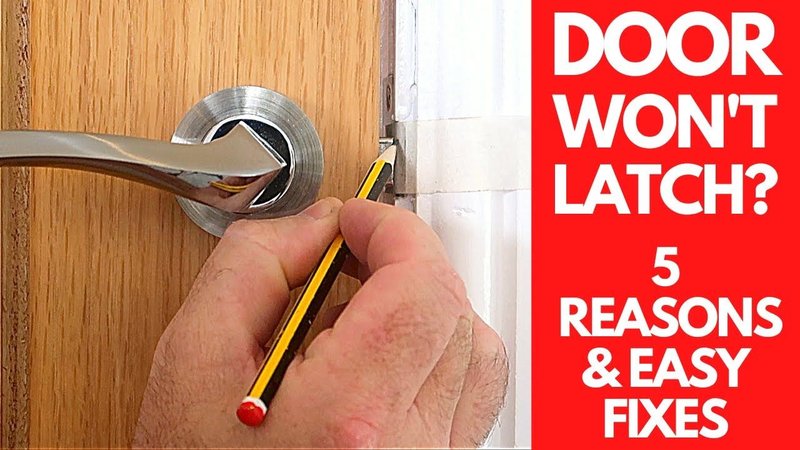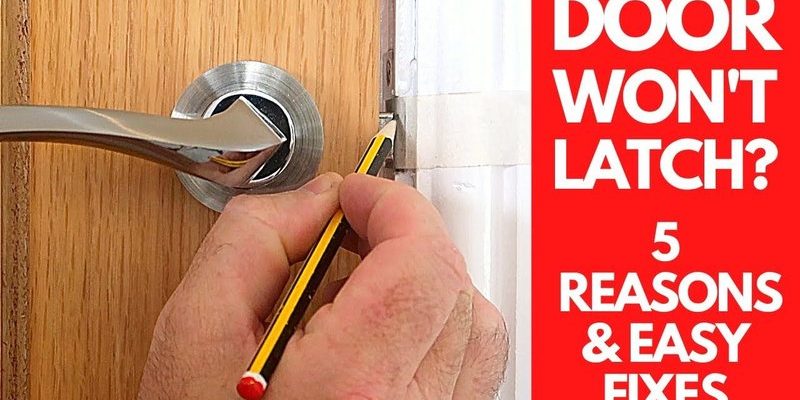
Let’s break down this frustrating scenario. A faulty door latch can result from various issues, from misalignment to internal damage. It’s a bit like having a car that won’t start; you usually have a few clues to figure out what’s wrong. Knowing how to troubleshoot can save you time, money, and a lot of headache. Whether it’s a simple fix or something that requires a bit more effort, understanding what’s going on can give you peace of mind—and maybe even prevent a repeat occurrence.
In this guide, we’ll explore the best ways to troubleshoot a door latch that simply won’t allow the door to open. We’ll dig into common causes, provide step-by-step solutions, and even sprinkle in some tips to avoid future mishaps. So grab a coffee, and let’s dive in!
Understanding the Parts of a Door Latch
Before we jump into troubleshooting, it’s essential to know what you’re dealing with. A door latch is made up of a few parts: the latch itself, the strike plate, and the handle mechanism. Think of it as a tiny team that works together to keep your door secure and allow it to open smoothly.
– Latch: This is the part that actually moves in and out of the door frame. When the door is closed, it locks into the strike plate.
– Strike Plate: This is the metal piece attached to the door frame that the latch clicks into place.
– Handle Mechanism: This is what you pull or push to engage the latch.
When one of these components misbehaves, it can lead to the door feeling stuck. It’s worth taking a moment to familiarize yourself with how they work together before we troubleshoot.
Common Causes of a Stuck Door Latch
You might be wondering, what could possibly go wrong with a simple latch? Well, here are a few common culprits that could keep your door from opening:
1. Misaligned Latch: If the door or frame has shifted, it can cause the latch to miss the strike plate. This is often the case with older homes or doors that experience frequent use.
2. Dirt or Debris: Sometimes all it takes is a little grime to mess things up. Dust or debris can accumulate in the latch mechanism, preventing it from moving freely.
3. Worn-Out Components: With time and use, latches can become worn or damaged. If you’ve had your door for years, it might just be time for a replacement.
4. Weather Effects: Changes in weather, such as humidity or extreme temperature, can cause wooden doors to swell or contract, affecting the latch’s operation.
Recognizing these issues is the first step. Understanding the problem makes fixing it much easier!
Step-by-Step Troubleshooting
Now, let’s get our hands dirty with some troubleshooting techniques. Here’s how to address a door latch that won’t allow the door to open:
1. Inspect the Door Alignment
First, check if your door is sitting properly within its frame. Is there a noticeable gap around the door, or does it look like it’s sagging? You might need to adjust the hinges or even tighten any screws that may have come loose.
– Tighten the Hinges: Using a screwdriver, secure the screws that hold the hinges to the frame. Sometimes a simple adjustment can bring everything back into alignment.
– Reposition the Hinge: If the door is sagging, you may need to reposition the hinge slightly. This might involve removing the hinge, adjusting its placement, and reattaching it.
Taking a close look at alignment can often solve the issue before you dive deeper.
2. Clean the Latch Mechanism
If alignment isn’t the problem, the next step is cleaning the latch. Dust, dirt, or debris can impact how the latch functions. Here’s how to tackle that:
– Use Compressed Air: Blow out any debris that may be clogging the latch. A can of compressed air can work wonders here.
– Apply Lubricant: After cleaning, consider applying a silicone-based lubricant. This helps the latch move smoothly and can prevent future sticking. Just be sure not to overdo it; a little goes a long way!
Cleaning can be a simple yet effective fix.
3. Examine for Wear and Tear
Look closely at the latch and surrounding components. Look for signs of wear, cracking, or bending, as these can lead to malfunction.
– Check the Strike Plate: Is it also damaged? Sometimes the strike plate can bend or become loose. If so, you may want to replace or reposition it.
– Replace the Latch: If the latch itself is worn out, it might be best to replace it entirely. You can find replacements at most hardware stores that match your current door’s specifications.
Taking the time to examine these parts can help identify any replacements you may need.
4. Test the Handle Mechanism
Don’t forget about the handle! If it feels loose or unresponsive, that might be part of your problem.
– Check for Loose Screws: Often, screws within the handle mechanism can work their way loose. Tighten them to see if that helps.
– Test the Handle: After tightening, try operating the door. If it still doesn’t work, you might need to remove the handle and have a look inside.
Paying attention to the handle mechanism is a crucial step.
Preventing Future Door Latch Problems
Once you’ve tackled the immediate issue, you’ll want to do your best to prevent it from happening again. Here are a few easy tips:
– Regular Maintenance: Every few months, check your door hinge and latch for signs of wear or misalignment. A quick inspection can save you from bigger problems down the road.
– Protect from the Elements: If your door is exposed to moisture, consider using weather stripping or sealing to protect it from wood damage.
– Consider Professional Help: If you regularly face issues, it might be worthwhile to call a professional locksmith for a more thorough evaluation.
Creating a regular maintenance schedule can help keep your door in top shape.
When to Call a Professional
Sometimes, no matter how many steps you take, you still can’t solve the problem. Here’s when you should consider calling in a pro:
– If you notice significant misalignment that you can’t fix on your own.
– If the latch gets stuck repeatedly, even after regular cleaning and lubrication.
– If you’re unsure about replacing components and want to ensure proper installation.
Calling a professional can save you time and give you peace of mind, especially for persistent problems.
Dealing with a door latch that won’t allow the door to open can be frustrating, but it’s a solvable issue. By understanding how your door latch works and following the troubleshooting steps, you can resolve many common problems yourself. Whether it’s adjusting a misaligned door, cleaning the latch mechanism, or replacing worn parts, many solutions are straightforward.
Taking the time to maintain your door latch not only saves you hassle but helps ensure your door functions smoothly for years to come. So the next time you find yourself stuck, remember these tips. You’ll be ready to either tackle the issue yourself or know when to call in the experts!
